#kevin kiner
Text
Me, pretending be a normal, non-obsessive Star Wars fan: yes I liked the Ahsoka end credit sequence the Normal Amount
Also me, to anyone that will listen: note the use of the taiko drums to bring us back to Ahsoka's samurai/Japanese aesthetic as opposed to the Mandalorian's cowboy/Western aesthetic; the presence of non-Jedi force-users such as loth-wolves and purrgils suggesting Ahsoka's continued journey engaging with the Force beyond the Jedi-Sith binary; the weaving in of historical Star Wars soundtrack motifs such as Where the Sun Sails and the Moon Walks and Burying the Dead; and the exquisite timing & placement of actors' names within the sequence e.g. Natasha Liu Bordizzo when Sabine's theme from Rebels begins to play, David Tennant in the visually busiest and connected section of the star map indicating Huyang's long life and extensive connections, and Eman Esfandi at the visually most lonely part of the star map as the journey line heads into isolation. Also note the intensification of the taiko drums during Sabine's theme, an intriguing juxtaposition of the "Jedi" (/samurai) identity and "Mandalorian" (/cowboy) identity, linking both identities with Sabine, and linking Sabine and Ahsoka in the audience's mind. In this essay I will-
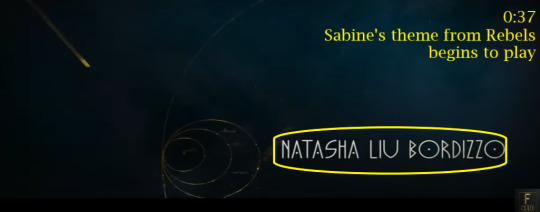
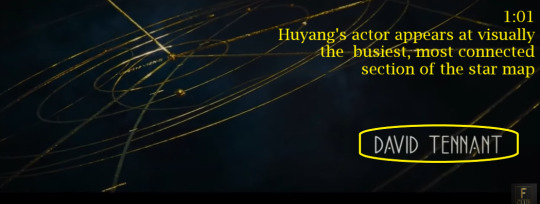


#literally started crying when I went back and watched Trials of the Darksaber to confirm Sabine's theme#have listened to this track on Spotify 6 million times#ahsoka#ahsoka tano#star wars rebels#star wars#star wars discussion#ahsoka end credits#star wars music#sabine wren#kevin kiner#ezra bridger
282 notes
·
View notes
Text
Kevin Kiner you goddamned genius.
I’ve always enjoyed the music of the Bad Batch, but holy shit. This is such a subtle thing that almost nobody would recognize consciously, but it adds SO much subtext to the scene at the end of the latest episode:
Crosshair’s theme changes. Since the very first episode of the Bad Batch when he confronts them in the hangar after being brainwashed, his music has been defined by synth. But in the last few moments of The Outpost, Crosshair’s theme evolves. The notes are the same, but they’re not synth anymore.
They’re BRASS.
“Why is brass important?” you may ask.
Because clones, and ESPECIALLY their valor/honor/duty as soldiers, are defined by brass. Listen to the first 30 seconds or so of this song, the clone theme from TCW:
youtube
Now close your eyes and listen to the music of the last few minutes of “The Outpost.” Listen to Crosshair’s theme as he watches the vulture’s shadow on the ground. Then again, as he stands up and makes his choice to avenge Mayday. There’s less and less synth, replaced instead by organic string instruments.
And then, after he avenges Mayday, the honorable choice, he collapses. It changes to BRASS.
The music acknowledges Crosshair’s growth from a good soldier following orders to a man choosing to do the right thing. Holy shit.
#ALSO#when he passes out there’s a close-up of his face#and sound effects from clone hangars play#which is such a nice fucking touch#kevin kiner#and the sfx team#are putting so much love into this season and it SHOWS#crosshair#tbb crosshair#ct 9904#the bad batch#tbb#star wars#tbb hunter#tbb echo#tbb tech#tbb wrecker#sorry for the tag spam#I NEED people to notice this too#cyarinka.txt#music theory#analysis#tbb s2 spoilers#the bad batch season 2#the bad batch spoilers#tbb spoilers
606 notes
·
View notes
Text
Anakin & Letting Go
I always found it to be a little skeptical that Anakin could become a force ghost after it took Yoda, Qui Gon, and Obi-Wan learning and training how to do it, and I always thought “really? Anakin? Finding that level of peace and letting go?” But after this episode, seeing the care and lesson that he imparts upon Ahsoka that he learned so painfully, I understand it from him so much better. Vader was so stuck in his complete self-hatred that he allowed nobody who had known him before as Anakin to reach him (most notably Obi-Wan and Ahsoka) because of the overwhelming extent of his shame. It took his son, who had never known him and yet who still stood before him and believed in him, loved him, sacrificed himself for him, to call Anakin back from the depths of Vader. And this Anakin, let everything go to save his son and to allow his son to save him.

And it felt so impactful to get to see this mature post-Vader Anakin reaching out to Ahsoka to teach her this very hard-earned lesson that he took the very hard road to get. Because she has Vader in her. She is everything Anakin taught her, and we saw the behaviors that led Anakin to becoming Vader—the fear of losing his most cherished relationships—reaching out of Anakin very early in the clone wars (and before) and the two of them are both very aware that he imparted those lessons on her. And then we've seen across this season—and overtly in her clone wars flashbacks—that she believes she is inextricable from these traits.

I’ve always loved Anakin as a fictional character, getting to see his earnestness, his flawedness, and his intensity (to borrow Huyang’s very accurate adjective), but this episode brought a level of humanity to him that has moved me so deeply. Life is HARD, loss gets forced on all of us no matter what, and the lessons that we learn through mistakes that we made can be extremely painful because acknowledging and taking responsibility for hurting people is actually really painful for humans (not owning up to our actions is the emotionally easier choice and George Lucas has stated time and again that the Dark Side is about taking the short-term easier choices). But it ultimately means that learning from your mistakes is an actual choice you have to MAKE. And this is the core of Anakin’s lesson. He is teaching Ahsoka that she has to choose which lessons he has taught her that she will live by, but more than that, that she is empowered to be able to choose. Yes, she has everything that he taught her—the good and the bad—but she is not condemned to live out all of the lessons.
And the beauty of it isn't just the lesson, but that Anakin gets to be the one to teach it to her. The betrayal that she experienced in discovering his fall, the taintedness that she has been portraying that she feels about herself, gets specifically addressed because if he figured it out, then she definitely can too. If he is more than just Vader, then she is too. And THAT is what the "Is that what this is about?" line is actually about. It's so so important that we get to see pre-Vader, Vader, and post-Vader across her vision because the point is that yes, Vader is a part of him, and that brilliant shot of the two of them glaring Sith eyes across the blade at each other did it's job in conveying that Ahsoka is capable of that darkness too, but you are not only the darkness. You get to choose. ("You're more than [death and destruction] because I'm more than that"). And more to the point, you have to choose. Because if you don't specifically choose to fight the dark, then you're ultimately choosing to fall into it. "Fight or die."
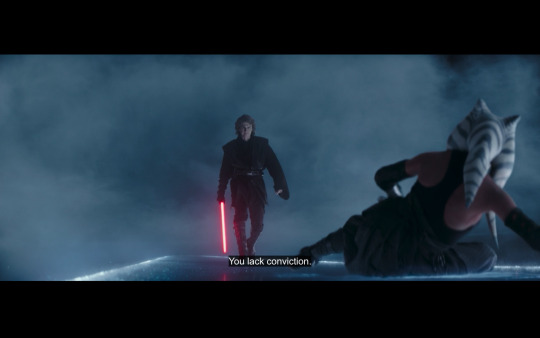
So for Anakin to be able to reach out to her one more time, to be able to love her the way he, as Vader, had refused to the last time when they met on Malachor, and to open with “you’re never too old to learn”, because god if he didn’t learn that the hard way too. And to be able to pass on to Ahsoka how to actually let go because he himself had only just finally been able to learn it as well, feels so powerful and poignant.
And that look of pride and wistful sadness that he gives her at the end? That both she and Luke were able to learn so quickly what took him so long? And that maybe, he may have helped save her from the worst traits that he imbued upon her? That’s him having let go of his own shame. He feels grief, he feels guilt—we can see it on his face—but what has happened has happened and he has accepted that, and finally learned that letting go doesn't mean it didn't happen, it means it doesn't have to define your actions going forward.
And finally, it’s also him letting go of ahsoka. By teaching her that she will choose her destiny, he has to accept that he cannot control it either. And he has. “There’s hope for you yet.”
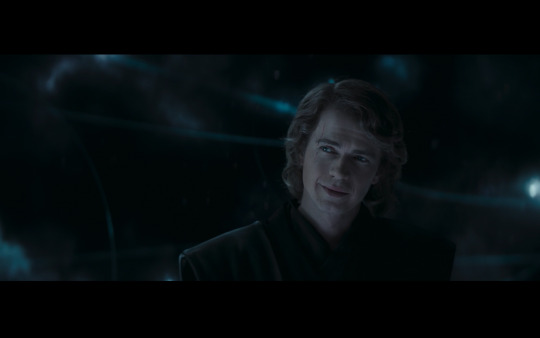
So yeah, Anakin learned to let go, and getting to see him here, in this headspace of acceptance and peace, practicing and understanding what it means to be a Jedi, was so unexpectedly cathartic and revelatory for me as viewer.
#listen this lesson IS HIS APOLOGY. he didn’t get it then but he gets it now so please ahsoka#here are the tools to break the cycle of fear and violence#i love you snips i love you snips i love you snips#i love anakin as a character but I never thought I would feel as proud of him as I do now#say what you will about filoni but to me this episode proved he actually gets the ethos at the core of star wars#I also finally feel like the show has earned the emotional sucker punch of an end credits score that kevin kiner gifted us with#ahsoka series#ahsoka meta#ahsoka show#ahsoka spoilers#anakin skywalker#snips and skyguy#ahsoka tano#darth vader#dave filoni#kevin kiner#my meta#ahsoka shadow warrior#man this was so much longer than i expected. let me tell you im a victim of parental abuse without telling you im a victim of parental abus#writing this out had me SOBBING y'all#ahsoka gets the reparation we all deserve
218 notes
·
View notes
Text
Ahsoka Episode 6 “Far, Far Away”: The Story, the Symbolism, and the Score
Episode 6 of Ahsoka begins with the sound of distant purrgil calls as Ahsoka and Huyang travel through hyperspace, crossing the void between galaxies. During their discussion of the tales Huyang used to tell the Jedi younglings there is no music.


I loved that Huyang said such an iconic line in this episode, reminding us that this is indeed a fairy tale, a children’s story.
The Title Card for Ahsoka appears, and then the episode title, “Far, far Away.”
We hear ominous music when Sabine is in the brig onboard the Eye of Sion. The window to her cell is shaped like an upside down triangle.
The sinister music continues during the scene with Baylan, Shin, and Morgan on the bridge. Morgan’s Theme (the Nightsister theme) is heard when the Eye of Sion exits hyperspace.
The line “Peridea is a graveyard” reminds us that this is indeed a “descent into the abyss” a stage of the hero’s journey which I have discussed on this blog before. Ominous music plays here.
The characters who are aligned with the dark side are on a quest for more power to dominate others. They have followed the Path to Peridea as a kind of path to perdition as I have mentioned in my previous metas. But Sabine, our heroine, is descending into the Underworld on a more noble quest. She hopes to find her beloved Ezra Bridger, echoing the story of Orpheus, the hero of Greek myth who descends into the Underworld to find his beloved Eurydice.
Morgan’s Theme continues when they board the shuttle and descend to the planet Peridea.
The landscape of J. R. R. Tolkien’s Middle-earth is suggested by the giant statues and the Nightsister fortress, which resembles an evil version of Minas Tirith.
The characters encounter three Nightsisters, analogous to the Three Fates of Greek mythology, the Moirai. (Note the similarities between this word and the name of Ahsoka’s owl, Morai, a creature I predict that we will be seeing again soon.)
The three Fates were the personification of destiny in Greek mythology. The three sisters were known as Clotho (the spinner), Lachesis (the alotter), and Atropos (the unturnable, a metaphor for death). The end credits for this episode name these three Nightsisters as Klothow, Lakesis, and Aktropaw, clearly indicating the intended symbolism of these three characters. As George Lucas said back in the late nineties, “Well, when I did Star Wars I consciously set about to recreate myths and the — and the classic mythological motifs. And I wanted to use those motifs to deal with issues that existed today.” (From billmoyers.com) Lucas’ apprentice, Dave Filoni, has learned this lesson from the master himself.
The music is quieter in this scene, with sounds of low vibrations being heard. Morgan’s Theme continues when Sabine is imprisoned by the Nightsisters’ three orbs, which held her bound within a triangle made of red cords of energy.
Outside of the fortress three wolf-like creatures howl as ominous music plays. Choral music suggesting the mysticism of the fallen Jedi Order is heard as Baylan speaks of Peridea being a realm of “dreams and madness” from old “children’s stories come to life.” Once again, the viewer is reminded that we are being told a fairy tale, a myth. The musical score subtly teases the listener with three notes from Ahsoka’s Ronin theme in this scene.
Sabine is imprisoned inside the Nightsister fortress as the Chimaera arrives with the sound of ominous metallic rumbling. Thrawn’s flagship Star Destroyer was named after the female fire-breathing monster in Greek mythology which was part lion, part goat, and part dragon.
I am no Freudian, but the Chimaera’s open docking bay hovering over the phallic tower of the Nightsister fortress seems to be the most overtly sexual symbolism I have seen in Star Wars in a long time. However, I’m not here to discuss that visual metaphor.

Organ music which anticipates but does not present Thrawn’s theme is heard as the Nighttroopers muster under Enoch’s command. These undead stormtroopers have cracked armor repaired with golden seams suggesting the Japanese art of kintsugi, as well as armor pieces bound with bands of red cloth. They are heard chanting “Thrawn! Thrawn!” as the Grand Admiral makes his dramatic entrance. For me this chant was reminiscent of how the orcs in Return of the King chanted “Grond! Grond!” when using their mighty battering ram against the walls of Minas Tirith. (You can do your own Freudian analysis of that scene. I’m not going there.) What was Grond?
“Grond, also known as the Wolf's Head, was a one hundred-foot long battering ram with a head in the shape of a ravening wolf, used in the arsenal of Sauron in the Third Age. Though named for Grond, Morgoth’s warhammer, it was created in the likeness of the Wolf of Angband, Carcharoth.”—from lotr.fandom.com
Creepy music accompanies the Nighttroopers as they transfer of cargo from the catacombs beneath the fortress. What is inside them? Dead Nightsisters, waiting to be revived by dark magic?
Thumps and low pitched sounds accompany Thrawn’s conversation with Baylan.
Thrawn speaks of Sabine’s desire to be reunited with her long-lost friend. (The word desire is a very intentional word choice, with the connotation that the connection between Sabine and Ezra has potential to be more than just friendship.)
Sabine: I’m sure he’s doing just fine.
Thrawn: You gambled the fate of your galaxy on that belief.
Sabine: You wouldn’t understand.
Thrawn: Perhaps not.
Evil does not understand love and loyalty. (See my previous post about the Path to Peridea.)
Enoch returns Sabine’s weapons to her, and she is provided with provisions and a wolf-like howler for a mount. He tells her to “die well” as she embarks on her “fool’s errand.”
The line about a “fool’s errand” calls to mind this scene from Tolkien’s novel, The Return of the King:
'Tell me,' he said, 'is there any hope? For Frodo, I mean; or at least mostly for Frodo.'
Gandalf put his hand on Pippin's head. 'There never was much hope,' he answered. 'Just a fool's hope, as I have been told…”
“A Fool’s Hope” was also the title of the penultimate episode of Star Wars Rebels final season.
Once again, Thrawn’s theme is only hinted at by the organ music at the end of the scene.
Sabine’s scanner is destroyed during her fight for her life with the red-armored bandits in the wastelands. Her life is saved by her Mandalorian armor and weapons, Ahsoka’s training, and Ezra’s lightsaber in this action sequence.
Baylan and Shin ride out on howlers. Nighttroopers load coffin-like cargo containers onto the Chimaera as uneasy music plays. Thrawn decides to dispatch only two squadrons of Nighttroopers. His disdain for Jedi, light or dark, is apparent: “It matters not whether Wren and Bridger are killed or stranded here. The same can be said for your two mercenaries.” Ominous music plays.
The scene with Sabine and the howler is accompanied by gentle music played upon wooden flutes. Sabine processes her abandonment issues and her complex feelings for Ezra in this scene by taking out her emotions on the howler. “You. You abandoned me. I should have known you are a coward.” She tries to make the howler stop following her, but the loyal animal comes back as soon as she walks away. “Okay. Fine,” she says. “I’ll give you another chance, but you better not bail on me this time.” The gentle flute music continues. A motif of ascending perfect fifths suggests Ezra’s Theme.
The howler stops to drink water and sniffs the air. The thing that Sabine and the audience assumes to be a rock is revealed to be a sentient little hermit-crab-like creature called a Noti. Gentle music plays when Sabine kneels, puts down her blaster, and extends her hand to the creature. The Noti recognizes the Rebel Alliance symbol (an evolution of her own Starbird design) on her pauldron. The creature has a medallion of his own, marked with a similar symbol.
“Do you know Ezra Bridger?” Sabine asks, touching her heart. “He’s my friend.”
Ominous music plays as Baylan and Shin discover the dead bandits. Once again choral music is heard when Baylan reminisces about the Jedi Order.
It is also revealed that the Nightsisters are fleeing from a power that is greater than their own.
Baylan and Shin see the red Bandits in the distance. “The enemy of our enemy is our friend,” says Baylan, “for now.”
Peaceful and noble sounding music is heard when Sabine sees the Noti encampment. She smiles at the mother Noti rocking her baby in a hammock.
With Sabine in the foreground, the camera pans to show a now adult, bearded Ezra Bridger wearing a red robe and leaning against the wall of his home. “I knew I could count on you,” he says as joyful music plays, music which features the piccolo, flute, and other woodwind instruments.
The closed captioning for this episode says that there is captivating music playing when Sabine and Ezra finally embrace. We hear a beautifully orchestrated rendition of Ezra’s Theme on the French horn with a new countermelody in the strings to heighten the emotional impact of this long-awaited scene.


Ezra’s Theme is heard again when he says “Sabine, thanks for coming. I can’t wait to go home.”
When we return to where the Chimaera is docked with the Nightsister fortress, a suggestion of Thrawn’s Theme is heard at a quick tempo suggesting the urgency of the situation that is about to unfold. Ahsoka Tano is coming. “The thread of destiny demands it” is a line that further emphasizes the three Nightsisters playing the role of the three fates. We finally hear Thrawn’s Theme presented in an obvious way as the episode ends.
I have blogged about the magnificent end credits music in previous blog posts, so this time I am going to discuss something different: the alchemical symbolism in Ahsoka.
The central focus of alchemy was to transmute base metals into gold and create the elixir of life, as any aficionado of the lore of the philosopher’s stone knows. The process is a metaphor for the purification and transformation of the human soul to a state of perfection.
Three colors symbolize this process, black, white, and red.
First there is the nigredo (blackening) stage of the alchemist’s work, representing the breaking of the human spirit. This is where both Sabine and Ahsoka are at the beginning of the series.
Second is the albedo (whitening) stage, which involves washing away impurities or vices, and being ready to grow and learn again. This is most clearly illustrated by Ahsoka the Grey’s “death” and transformation into Ahsoka the White.
Third is the rubedo (reddening) stage, which is where we are in the story right now. It represents the purified and awakened spirit reaching its highest and purest form.
“The symbols used in alchemical writing and art to represent this red stage can include blood, a phoenix , a rose, a crowned king, or a figure wearing red clothes.”—Wikipedia.
The color red, of course, is symbolic of Nightsisters and their magic in this series, as well as symbolizing the red thread of fate.
Baylan Skoll’s line about having to “destroy in order to create” is an example of the alchemical concept of “solve et coagula” meaning to separate then join together. Nothing new can be built without destroying the old. Perhaps this is really telling us about the destruction and rebuilding of the Jedi Order.
In the completion of the rubedo stage there must be a union of sulphur and mercury, also known as the wedding of the Red King (the sun) and the White Queen (the moon). Sulphur represents the masculine principle, the soul, and the fire of life. (Remember Ezra’s red robe?) Mercury represents the feminine principle and the mind, flexible and changing. (Sabine is a clever young woman who lives inside her head, sometimes too much. Lately she’s been distracted by her heart.) Mercury also represents a state that can transcend death.
Is the much-discussed Ezra and Sabine hug the union of Sulphur and Mercury? Or should we expect something more than that?
Much has been written about Baylan Skoll and Shin Hati as the mythological wolves who chase the sun and the moon. This episode ends with the pair in pursuit of Ezra (sulphur, the Red King, the sun) and Sabine (mercury, the White Queen, the moon). When Skoll and Hati catch the sun and the moon, Ragnarok begins.
Besides sulphur and mercury, there is another element present at the rubedo stage of alchemical transformation: salt.
Ahsoka the White is coming.
Please reblog and comment on what you think of my musical and literary analysis of this episode of Ahsoka. I am looking forward to reading your replies.
#sabine wren#ezra bridger#star wars#ahsoka series#sabezra#star wars rebels#ezrabine#ahsoka tano#thrawn#baylan skoll#shin hati#morgan elsbeth#nightsisters#chimaera#j r r tolkien#dave filoni#george lucas#kevin kiner#star wars music#fates#mythology#alchemy
195 notes
·
View notes
Text
The score for when Echo leaves is called ‘Where I fit’😭

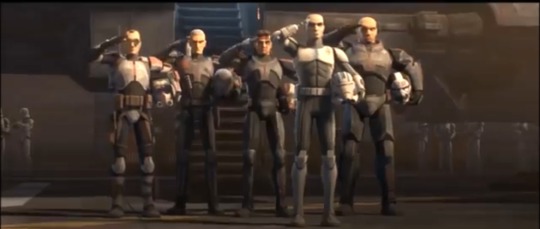

#why can’t TBB and Rex join up#Rex you look after our baby#kevin kiner#the bad batch#tbb spoilers#the bad batch spoilers#tbb#bb spoilers#bad batch spoilers#the clone wars#tbb echo#echo tbb#soundtrack#andors-oar
841 notes
·
View notes
Text
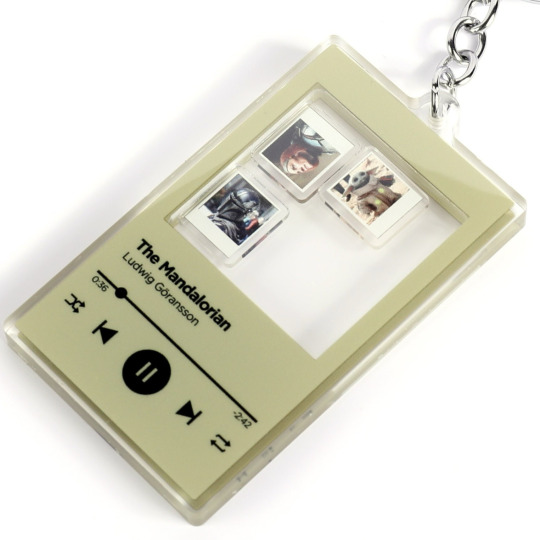






I just wanted to take a moment to share all 7 of my Star Wars score keychains! I marked these down to 30% off this week as a little treat as we get closer to the holiday shopping deadline.
The playlist:
The Mandalorian by Ludwig Göransson with Bo-Katan Kryze, Din Djarin, and Din Grogu
Fight in the Woods by Kevin Kiner with Baylan Skull, Shin Hati, and Marrok
Teaching You How to Lead by Kevin Kiner with Ahsoka Tano, Anakin Skywalker, and Captain Rex
March of the Resistance by John Williams with R2-D2, BB-8, and C-3PO
One Way Out - Part 8 by Nicholas Britell with Cassian Andor, Ruescott Melshi, and Kino Loy
Padmé by Kevin Kiner with handmaidens Sabé, Saché, Rabé, and Dormé
Yub Nub by John Williams with Wicket W. warrick & the Ewoks
Enjoy! Shop is here.
#star wars#rogue one#cassian andor#andor#etsy artist#etsy shop#andor series#star wars sequels#Ewoks#kino loy#ruescott melshi#baylan skoll#ahsoka tano#ahsoka series#shin hati#marrok#kevin kiner#anakin skywalker#captain rex#r2d2 and c3po#r2d2#bb8#droids#padme amidala#naboo handmaidens#handmaiden sabé#the mandalorian#bo katan kryze#din djarin#din grogu
56 notes
·
View notes
Text
Sabine Wren (Musical Analysis)
Music Reveals Her Nature
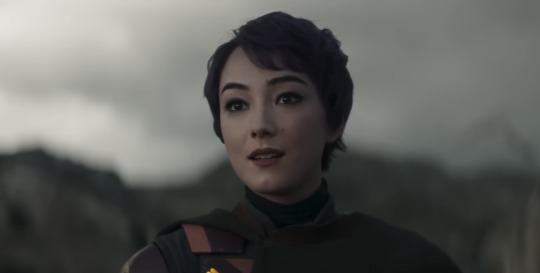
If there’s one thing we can all agree on regarding Ahsoka, it’s that the Kiners absolutely did their best work on this show.
Music is essential to Star Wars and they absolutely understood the assignment.
If you haven’t listened to the Ahsoka soundtrack yet, please do yourself a service and do so immediately.
For this quick analysis, I want to shout out a nice bit of character motivation/foreshadowing they did for a pivotal scene in Ahsoka 1x04.
First, take a listen to this soundtrack called Ezra’s Recording. The part that’s most important is towards the end, starting at the 2 minute mark.
youtube
Obviously, the music plays during this scene:
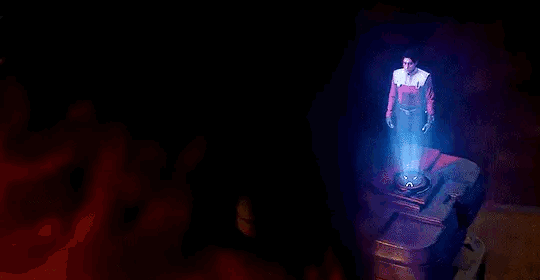
Fast forward to 1x04. And we have the scene where Ahsoka presents Sabine with a grim outcome: if they are unable to obtain the map, then it must be destroyed to prevent Thrawn’s return.
Now listen closely, keeping in mind the musical section I pointed out from Ezra’s Recording:
youtube
Did you hear it?
That’s right. That specific musical verse from the end of Ezra’s Recording plays out in this one (for the curious, the track in this scene is called ‘Can I Count On You?’).
If Sabine’s actions weren’t already a huge red flag for who she was thinking about - and what she was going to do - then the music makes it pretty clear where her heart is.
Phenomenal work from the Kiners. Can’t wait to hear from them again.
#sabezra#sabine wren#ezra bridger#star wars rebels#ezrabine#star wars#ahsoka show#ahsoka#kevin kiner#Youtube#natasha liu bordizzo
71 notes
·
View notes
Text

Mr Kiner thank you for giving my hyperfixations the soundtrack they deserve
#kevin kiner#star wars rebels#The clone wars#The bad batch#This guy! Has helped make star wars! What it is!#AHSOKA'S THEME#KANAN'S THEME#SABINE'S THEME#WHERE THE SUN SAILS AND THE MOON WALKS#JOURNEY INTO THE STAR CLUSTER CHANGED ME AS A PERSON
68 notes
·
View notes
Text


10 years later and Ahsoka Leaves has me in tears
#that music sent me#it was such a hopeful version of a devastating memory#its so much happier and they are happier with each other#kevin kiner#Ahsoka leaves#anakin and ahsoka#ahsoka#ahsoka and anakin#ahsoka tano#anakin skywalker#the clone wars#star wars#star wars: ahsoka#anakin#the jedi the witch and the warlord
136 notes
·
View notes
Text
"Omega's Theme" from The Bad Batch season 1 soundtrack just popped up on my playlist and my heart lurched and I got a little teary.
Our young girl has come so far and seen so much.
I'm sure, whatever happens in the series finale, it will end with an iteration of this theme that will be a combination triuimpant, melancholy and hopeful.
My body is not ready.
#The Bad Batch#The bad batch season 3#star wars#tbb omega#tbb echo#arc trooper echo#tbb hunter#tbb tech#tbb wrecker#tbb crosshair#kevin kiner#music#The bad Batch ost#Spotify
24 notes
·
View notes
Text
Can’t wait to see what the Kiners named the song that played in the background when Shin and Sabine just glared at eachother.
#shin hati#wolfwren#kiners#kevin kiner#sabine wren#sabine wren x shin hati#shin hati x sabine wren#star wars ahsoka#ahsoka#ahsoka spoilers#ahsoka show#ahsoka 2023#ristarwars
81 notes
·
View notes
Text
The end credits music is phenomenal ;_;
#star wars#the bad batch#crosshair#hunter#tech#wrecker#echo#omega#tbb spoilers#tbb season 3#kevin kiner
21 notes
·
View notes
Text
Kiner fam bringing their A-game this episode (as always)
absolutely delighted and sobbing over how Omega's Theme plays when she hugs Hunter
and how, when Hunter and Wrecker finally see Crosshair, it turns into a slowed-down, not-happy-not-sad-very-sombre version of the Bad Batch Theme nope, my bad, that's Crosshair's Theme, i think?!
🎧😭
24 notes
·
View notes
Text
Ahsoka- Notes on Episode 5 “Shadow Warrior” and Kiner’s score
Episode 5 begins with mystical sounds of Seatos, including the sound of the ocean waves and mysterious music as the setting is established. When Hera appears at the henge, the music subtly suggests the selections from the Rebels soundtrack associated with Kanan’s death (see “Nobody More than Kanan” and “Kanan’s End Credits”). A sweet, innocent sounding theme is associated with Jacen when he exits the Ghost with Chopper. Hera sees that Huyang has recovered Sabine’s helmet, but she and Ahsoka are nowhere in sight.
youtube
youtube
The Ahsoka main and episode titles appear, followed by a continuation of Ahsoka and Anakin in the World Between Worlds scene from the previous episode. Quiet music accompanies their conversation until the duel begins.
Back at the henge Jacen says there is something about the water. Music becomes a little more intense when Jacen and Hera listen. When Jacen says he hears lightsabers, both a segment of Kanan’s Theme by Kevin Kiner (flute) and the Force Theme by John Williams (French horn) can be heard. The music is used to enhance the idea that young Jacen is Force sensitive like his father, Kanan. Hera orders her pilots to continue the search for Ahsoka. Kanan’s theme is heard once more when Huyang explains to Carson Teva that Jacen’s father was a Jedi.
Ahsoka’s duel with Anakin continues. Ahsoka’s Theme is heard after she kicks Anakin in the head and says “Looks like you don’t have much left to offer.”
A scene of young Ahsoka with Anakin during the Clone Wars follows, accompanied by incidental music that doesn’t refer to major themes.
Ahsoka’s Theme is heard when she comforts the wounded soldier on Ryloth.
Jacen remains at the henge with Chopper as Hera, Huyang, and the surviving pilots continue the search.
During the scene of young Ahsoka at the Siege of Mandalore, an augmented presentation of the heroic Clones’ theme can be heard during and after Rex’s dialogue. (The note values are elongated. Listen to the trumpet part.) Ahsoka’s theme is heard during her conversation with Anakin. The music becomes more sinister and intense when Anakin/Vader draws his lightsaber and another duel begins.
Adult Ahsoka duels Vader in the World Between Worlds. Music ceases when she deactivates her saber and says “I choose to live.” The score resumes when Anakin says “There’s hope for you yet.” Mysterious music with a choral vocalization accompanies her descent into the water. She is rescued by the X-Wing pilots.
Ahsoka’s theme plays as the ships return to the henge. Peaceful music featuring the piano is heard as Ahsoka awakens aboard her Jedi starship. Sabine’s theme is heard when Huyang hands Ahsoka the broken star map. Ahsoka uses psychometric powers to examine the map. She discovers that Sabine went with Baylan and the others aboard the Eye of Sion.
When Ahsoka sees the Purrgil flying across the sky, the hopeful-sounding ostinato that I associate with Sabine’s search for Ezra is heard. This is the same ostinato that plays during the “Path to Peridea” portion of the end credits music. Ahsoka’s priorities have changed. She is now concerned with finding Sabine and Ezra rather than stopping the war.
An augmented version of the “Path to Peridea” becomes a theme with a definite conclusion as the scene ends.
Hera talks with Mon Mothma’s hologram. Hera’s command is in jeapordy of permanent suspension.
Beautiful, majestic music accompanies the starships’ flight through the purrgil pod.
Incidental music that is a little tense but non-threatening accompanies Carson Tera’s conversation with the New Republic ship captain.
Majestic music accompanies Ahsoka’s communication with the Purrgil through the Force. The “Path to Peridea” ostinato resumes when Ahsoka returns to the interior of her ship, this time presented in counterpoint with Ahsoka’s theme. The ostinato is heard (sometimes with doubled pitches) throughout the scene with the New Republic starships until the purrgil pod jumps into hyperspace with Ahsoka’s ship.
As I stated in my episode 4 breakdown, the closing credits music begins with the now-familiar presentation of Kiner’s “ronin” theme, the duet for viola and cello with a pavane-like rhythmic accompaniment. This accompaniment continues during Sabine’s theme. The hopeful-sounding ostinato that I associate with the search for Ezra Bridger plays along the “Path to Peridea” portion of the journey across the star-map. The ostinato continues, accompanying an augmented version of Ahsoka’s theme. A triumphant presentation of Ahsoka’s Theme plays as all of the golden lines meet at Peridea. Hera’s Theme, featuring the French horns, strings, and trumpets plays as the credits continue against the black background, followed by the final reprise of Ahsoka’s theme.
This is the second episode of Ahsoka in which Ezra’s Theme is not heard even though he is mentioned. This might be the first episode that featured Kanan’s theme in association with Jacen’s Force sensitivity.
Edit: I realized there were hints of Kanan’s theme in the previous episodes when I listened to the Ahsoka Soundtrack album for episodes 1-4. I didn’t notice it when I watched the episode on Disney Plus though.
#star wars#ahsoka series#star wars rebels#ahsoka tano#sabine wren#hera syndulla#jacen syndulla#huyang#carson teva#ezra bridger#kanan jarrus#kevin kiner#star wars music#anakin skywalker#darth vader#captain rex#john williams
81 notes
·
View notes
Text
love how I immediately knew it was Thrawn before we even saw him because of the organ in the score
#ahsoka series#ahsoka spoilers#ahsoka series spoilers#kevin kiner#score composers for the shows never get enough love#and kevin kiner is the goat#thrawn#grand admiral thrawn#ahsoka#ahsoka show#ahsoka show spoilers#star wars#tv score#i love a good musical cue#sky speaks
60 notes
·
View notes
Text
Kevin Kiner is such a mad evil genius for hiding the imperial march in the Clones’ theme
98 notes
·
View notes